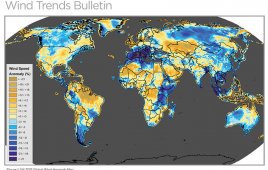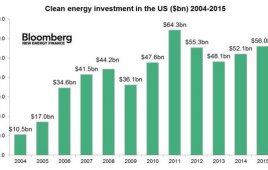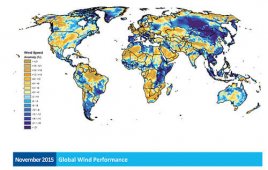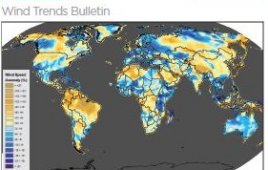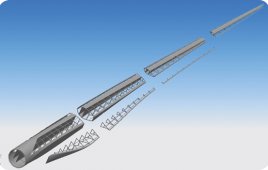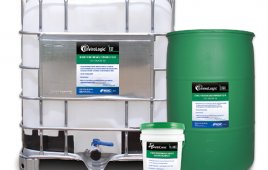AWS Truepower’s Wind Trends Bulletin is a report that evaluates deviations in global wind conditions from the historical norm on a monthly, quarterly, and annual basis. The purpose is to provide wind-plant owners, investors, and operators with a high-level analysis of wind resource performance influenced by climatic fluctuations. The maps contained in the report were derived…
Record 2015 clean-energy investment: $329bn spent globally
Clean energy investment surged in China, Africa, the U.S., Latin America, and India in 2015, driving the world total to its highest ever figure, of $329.3bn, up 4% from 2014’s revised $315.9bn and beating the previous record, set in 2011 by 3%. These latest figures from Bloomberg New Energy Finance show dollar investment globally growing…
AWS Truepower releases November 2015 Wind Trends Bulletin
AWS Truepower’s new monthly wind performance maps, released shortly after the end of each month, show deviations in the wind resource from average conditions in every region of the world for the preceding month. This service is an enhancement of the company’s current wind trends service, which provides a quarterly snapshot of wind performance. The…
AWS Truepower releases Wind Trends Bulletin for Q2 2015
AWS Truepower’s quarterly Wind Trends Bulletin for Q2 2015 is now available. The report provides wind-plant owners, investors, and operators with a high-level analysis of wind resource performance influenced by climatic fluctuations. This aids in identifying potential issues with wind plant underperformance. Some of the highlights of the Q2 2015 Bulletin include the following wind trends……
AWS Truepower releases Wind Trends Bulletin Annual Review for 2014
AWS Truepower’s Wind Trends Bulletin Annual Review provides wind plant owners, investors, and operators with a high-level analysis of wind resource performance influenced by climatic fluctuations. This aids in identifying potential issues with wind plant under-performance. Highlights of the 2014 Annual Bulletin include the following findings: winds were normal to above normal, with some exceptions,…
Trends in O&M
Global wind turbine O&M expenditures are expected to rise from $9.25 billion as of 2014 to $17 billion by 2020. That’s according to a recent report from consultancy firm GlobalData, which points to an increasing number of installations and aging turbines. GlobalData analyst Harshavardhan Reddy Nagatham said that maintenance is vital to the commercial viability…
Trends in safety
The global fall protection equipment market is expected to develop at a compound annual growth rate of just under 6% from 2015 to 2019. This is one prediction from a recent report by research and advisory firm Technavio. “Fall protection equipment is increasingly becoming an integral part of safety and protection equipment in the energy…
Trends in filters and lubricants
By one estimate, 80% of all breakdowns in lubricated machines are related to pollutants in the oil. Even in small amounts, contaminants can increase operating costs associated with maintenance, downtime, or equipment replacements. Enough particles measuring only 1-μm in size (invisible to the human eye) can knock out a 20-ton gearbox. The solution: rigorous particle…
Trend analysis: Where the wind industry goes from here
The wind industry trends – in a nutshell – are moving toward larger turbines to take advantage of the economy-of-scale, along with greater reliability and efficiency to bring down the cost of wind-generated power. The wind industry’s goal is to rival the cost of electricity generated from natural gas. Launching larger turbines is almost a…
Trends in wind forecasting and site assessments
Economic uncertainty and constrained capital have significantly increased scrutiny of potential wind projects. That makes accurate and timely site assessments more important for reducing financial risk. Even after projects are online, operators continue to look for ways to reduce O&M costs, while incorporating new technology to help them monitor farm conditions and alert them to…
Trends in utility scale wind turbines
If money were less of an object, developers would always put the largest turbines on the tallest towers possible. That would ensure the highest possible capacity factors from about 5-MW units and give a significant boost to power production. It would also, however, be costly. To find the right mix of turbines for the wide…
Trends offshore
The offshore wind-industry trends are just taking shape, but they seem to center around the turbines, their foundations, and the equipment and vessels needed to place them. That an offshore industry is testament to the persistence of Cape Wind developers (10 years of persistence) and finally, an accommodating administration that has opened the doors to…
Trends in transportation and logistics
The problem with moving wind-turbine components is their size–they are gigantic. Nacelles can measure 12-ft wide and over 20-ft long, while half of a tower can be 12-ft wide and almost 150-ft long. And blades –conversation stoppers on most highways– easily span 100 ft. Moving these structures takes special equipment, trucks, trains, ships, and harbors.…
Trends in simulation software
General purpose finite-element analysis has proven itself very successful at finding stresses in structures if you assume a steady load. But wind turbines present a range of engineering challenges that arise from large displacements, non-linear material properties, and time varying loads from air flows, conditions which challenge general purpose structural analysis. For these applications it…
Trends in wind power electrical components
Wind turbines have been maintenance nightmares for many operators over the past few years. This is to be expected when the rush to install wind turbines has avoided the usual developmental learning curve, on which new technologies mature by trial and error. Instead, many turbine designs have, until very recently, been taken from other industries…
Trend in towers
Towers for wind turbines have done a good a job hiding their high-tech origins. For instance, their sections–humbly called cans–are rolled from flat-sheet steel into precise, yet slightly tapered cones and then welded by CNC machines. More CNC machine tools drill holes and attach flanges that allow connecting cans. But for all their sophistication the…
Trends in sliprings
Sliprings work in the turbine’s hub where they transmit power and signals from stationary cables in the nacelle to rotating equipment in the hub. A slip-ring assembly is often a graphite or precious metal brush that contacts the outside diameter of a rotating metal ring. As the ring turns, electrical current or signal is conducted…
Trends in wind energy safety
When considering safety concerns with wind turbines, two main topics come to the top—technician safety and turbine safety. Technician safety prevention typically revolves around protective clothing, climb-assist technologies, and best practices in the field. Technician Safety Increasingly, companies are using rope-access techniques to perform work on wind turbines. Rope access technicians are highly-trained individuals providing…
Trends in lubrication
Global lubricant demand is forecast to reach 40.5 million metric tons in 2012. According to a recent study, the market is estimated at $48.8 billion. Companies in this booming market are expanding their lubricant lines to include those for more industries such as wind. Wind equipment requires specialized lubricants. For instance, they may require certain…
Trends in wind hydraulics
As in other areas of the wind industry, hydraulics engineers are looking for ways to improve turbine operating efficiency while reducing maintenance. This leads to a focus on preventative maintenance, rather than just replacing worn parts with new ones from the OEM. Research is also being conducted toward expanding hydraulics in wind transmission drives. Ken…

